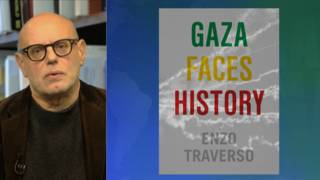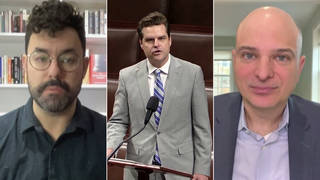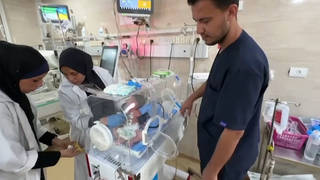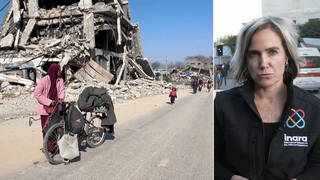
Related
Almost six months into Israel’s assault, Gaza’s health sector has been completely decimated. Before October 7, Gaza had 36 hospitals. Now only two are minimally functional, and 10 are partially functional, according to the United Nations. The rest have shut down completely after either being shelled, besieged and raided by Israeli troops, or running out of fuel and medicine. Israel’s assault has killed over 32,500 Palestinians, including over 14,000 children, and wounded nearly 75,000. We speak with Dr. Tanya Haj-Hassan, a pediatric intensive care physician who just spent two weeks volunteering and living at Al-Aqsa Martyrs Hospital in Gaza, about what she witnessed and the conditions of healthcare in the beleaguered and devastated territory. “This is not a humanitarian crisis. This is the worst of what humanity is capable of, and it’s entirely all man-made,” says Haj-Hassan. “This is an utter and complete failure of humanity, and, to be frank, I feel ashamed to be an American citizen. I feel ashamed to be part of a society that has allowed this to continue.”
Transcript
NERMEEN SHAIKH: Nearly six months into Israel’s assault on Gaza, the health sector has been completely decimated. Before October 7th, Gaza had 36 hospitals. Nearly six months later, only two are minimally functional, and 10 are partially functional, according to the United Nations. The rest have shut down completely after either being shelled, besieged and raided by Israeli troops, or running out of fuel and medicine.
The death toll from the Israeli assault has topped 32,500, including over 14,000 children, with nearly 75,000 wounded. The entire population of Gaza is facing high or catastrophic levels of acute food insecurity, and famine is imminent in the north. At least 27 people, mostly children, have died of malnutrition and dehydration.
AMY GOODMAN: In Al-Shifa Hospital in Gaza City, the largest hospital in Gaza, an Israeli raid is continuing for the 10th day. Israeli forces there have killed at least 200 people and detained over 400.
Meanwhile, the U.N. reports that as of Tuesday, Al-Amal Hospital in Khan Younis has ceased functioning. That leaves the remaining hospitals in Gaza that are able to partially function completely overwhelmed. One of those is the Al-Aqsa Martyrs Hospital in Deir al-Balah in central Gaza. Our next guest just spent two weeks volunteering at and living there with a team of international doctors.
Dr. Tanya Haj-Hassan is a pediatric intensive care physician who works with Doctors Without Borders. She’s co-founder of the social media account @GazaMedicVoices, which shares firsthand accounts from healthcare professionals in Gaza. She just left Gaza yesterday. She’s joining us now from Amman, Jordan.
Tanya, welcome back to Democracy Now! I know you’re absolutely exhausted. Can you just share your experiences of the last two weeks, what you feel it’s most important for people around the world to understand?
DR. TANYA HAJ-HASSAN: Yeah, certainly. Thank you. Just to clarify, I was in Gaza with a charity called Medical Aid for Palestinians UK, MAP UK.
It’s really difficult to describe in words the horrors that we saw in our two weeks there. You know, you watch the news, you have some idea of what you’re going to see. But experiencing in real time entire family structures collapsing, entire families being wiped off the civil registry, having to tell a father or a mother that their entire family, their lifelong partner and all of their children, have just been killed and you weren’t able to resuscitate them, is something that was very difficult to experience and something that I hope I never have to experience again. And frankly, it’s something that I just feel ashamed that we’re still talking about, you know, seven months into this. It just is such a stark representation of our failure, of our failure as humanity. This is not a humanitarian crisis. This is the worst of what humanity is capable of, and it’s entirely all man-made. And when you witness it firsthand, it’s an unbearable injustice.
NERMEEN SHAIKH: Well, Dr. Tanya Haj-Hassan, thank you for that account. If you could also talk about some of the nurses with whom you worked? For our television viewers, you’ve seen some of the images that Tanya sent to us. And if you could speak specifically about a nurse whose name you cannot reveal for security reasons, who holds in his hand an infant, which we’ll show now on screen? If you could talk about the story of what happened with this nurse and the child in his hands?
DR. TANYA HAJ-HASSAN: Yeah, certainly. I think this photo is very representative of the utter exhaustion and yet ongoing determination of the healthcare staff there. Healthcare workers in general have been targeted since day one, as have health facilities. Al-Aqsa Hospital is a smaller hospital in the scheme of Gazan hospitals. The largest two hospitals are, first, Al-Shifa Hospital and, then, Al-Nasser Hospital. And as you mentioned in your introduction, both of them have been directly besieged. They’ve been targeted, bombed, deprived of resources. Their healthcare staff have been forced to flee. Many of the healthcare workers are arrested. They describe — they describe changing out of their scrubs or being told by civilians to change out of their scrubs when they’re fleeing. We’ve had civilians give healthcare workers their own clothes so that they’re not seen wearing scrubs, because we know that healthcare workers have been systematically targeted in this particular — in this particular war. So, I think I wanted to start by saying healthcare workers are under an enormous amount of pressure. They’re directly targeted. These healthcare workers evacuate, travel a very long way, and then, ultimately, are back at work, work extremely hard, do all that they can to keep patients alive.
And in this particular photo, this particular nurse, one of the most hard-working nurses that I worked with, had come to the end of a 24-hour shift, had tried very hard to resuscitate this infant, and unfortunately was unable to, and then just passed out, out of exhaustion, onto the stretcher in front of him, carrying the now-dead child. A lot of times we can’t even tell the parents that their child has been killed, because there are no parents to be found. And that’s, unfortunately, a very common occurrence.
In many of the other photos that you’ll see in front of you — I’m not sure which photos, Democracy Now!, you’re sharing; I can’t see them on my end — but you can see the carnage, the very difficult circumstances under which the emergency room department is trying to operate. A lot of the senior doctors have fled. Junior doctors, who are straight out of medical school, are on call overnight, receiving mass casualties, mass casualties with stories I can share with you, but stories that are very difficult and unbearable to experience, let alone talk about. But I’m happy to share more.
AMY GOODMAN: Can you talk about where you stayed; if you slept, where you slept?
DR. TANYA HAJ-HASSAN: Yeah, we slept in a room in the hospital. They had the female healthcare workers in one room on mats, and the male healthcare workers in another room. And we basically worked day and night. We had a surgical team with us that operated through most of the night just so that we can get through the very large backload of cases. I mean, this is a very small hospital that has a capacity of about 200 patients and is running with over 700 patients at the moment, and then there are thousands of internally displaced people there, as well. So they have a backlog of patients that require medical attention, that require surgical procedures, to prevent their wounds from becoming infected, to stabilize fractures. And, unfortunately, they don’t have the surgical space or workforce to get those cases done. So our team was just trying to offload some of that work. The teams there are also just utterly exhausted. I mean, they’ve been doing this for over 170 days. We did it for two weeks, and we’re exhausted. I cannot begin to fathom what it feels like for them.
NERMEEN SHAIKH: And, Dr. Tanya Haj-Hassan, if you could — you mentioned, in the image that you sent us and that we showed of the child in the nurse’s hands — you said that there were no parents or family members to whom you could convey the information of what happened to this child. The last time we had you on, you spoke about this new acronym, “wounded child, no surviving family.” Obviously, this child was among those. If you could talk about the number of children who were coming in, either on their own or who were left on their own?
DR. TANYA HAJ-HASSAN: Yeah, certainly. In fact, there are a number of them that are living in the hospital at the moment and being cared for by strangers or relatives. Often what happens is we’ll receive children, dead or still alive. We’ll attempt to resuscitate them, and we’ll start asking around, “Does anybody know if there’s family for this child in the hospital that have come in with the same mass casualty?” And we’ll have a distant relative look at us and say, like, “They’ve unfortunately been martyred,” or “They’ve been killed.” And so, it was a very common occurrence to have a child that we were resuscitating and not know if any of their family were alive, or be told that their family had been killed, or be told that that other woman that we’re resuscitating simultaneously on the floor is the child’s mother.
I remember one incident where we received a young boy who the side of his face had been blown off, and we were providing care for him while providing care for his sister in the adjacent bed. His sister had 96% of her body burned. Their parents and all of their other siblings had been killed in the same attack. And he kept asking for his family, and he had a distant cousin who was at his bedside, who kept saying, “They’re fine. They’re fine. They’re injured. They’re going to be fine.” And he kept saying, “Where’s my sister?” He could see the patient next to him. He just couldn’t recognize her, because she was so badly burned. But that was his sister. She unfortunately died despite our efforts. A 96% body surface area burn is essentially a death sentence, particularly under those resource circumstances. She died a couple days later in the intensive care unit. And he is still in the hospital receiving reconstructive surgery for his neck and face. But as of the moment I left, his distant relatives hadn’t had the heart to tell him that they had all died. He was suspecting it. So, when I would pass by to check on him, he would say, “I have a feeling my family has been martyred. I wish I had been martyred, too.” So I think he knows. But it’s utterly unbearable.
There’s another child that has an external fixator, so rods in his leg after some complex fractures, that, you know, lives in the hospital at the moment for ongoing care and is cared for by strangers because he doesn’t have any relatives in the hospital. And his car was bombed as they were trying to flee. And his family was killed, but he still thinks his family is in the north.
Other children know that their family has been killed, and are being cared for by extended relatives. Fortunately, their faith is strong, and they are able to rationalize, in whatever way this is — you’re able to rationalize these atrocities. I find them very difficult, if not impossible, to rationalize. This is an utter and complete failure of humanity, and, to be frank, I feel ashamed to be an American citizen. I feel ashamed to be part of a society that has allowed this to continue. And I am very much hoping and looking forward to the moment where we decide to take a courageous stance and put an end to this massacre.
AMY GOODMAN: Why did you go back, Dr. Tanya Haj-Hassan? You have been there a number of times.
DR. TANYA HAJ-HASSAN: So, I had been there over the last 10 years to teach. This is an area that’s been besieged for 16 years. And you have healthcare providers that are working under unimaginable circumstances before October 2023. And I think witnessing what was happening from a distance thereafter, witnessing the injustice, witnessing the immense pressure under which our colleagues were working, I found it unbearable not to be there with them. And, in fact, I probably felt most at ease in the last — since October, the moment I arrived in Gaza and knew that I could now actually join them in solidarity, in providing care for their patients, because they’re doing exactly — exactly — what we signed up to do in our Hippocratic Oath. And they’re doing it with a level of commitment and determination that is incomprehensible. It is so impressive. And yet they’re being attacked and directly targeted. And I think most healthcare workers that I know that are aware of what’s happening feel the same way I do and cannot wait to be there in person to provide solidarity, or are providing that solidarity in different ways from a distance.
NERMEEN SHAIKH: And as you were treating — Dr. Haj-Hassan, as you were treating children, people with such horrific injuries, if you could talk about the kind of equipment you had to work with? There are reports of aid trucks being denied entry because there were basic medical supplies, scalpels, scissors. Explain what doctors there have to work with as they confront these absolutely unimaginable injuries.
DR. TANYA HAJ-HASSAN: So, there’s certainly a shortage of a lot of things we need to work. And I think, at a very basic level, there’s just shortage of space. So, you can imagine, when we resuscitate a single patient that arrives into an emergency department, we put them in a resuscitation bed in a bay surrounded by equipment. That is not at all what’s happening in these hospitals. When you receive a mass casualty, the most critical cases get moved into this red area. There are three beds in the red area. And then the rest we resuscitate on the floor in the red area or the yellow zone. And so, we’ll have amputations that we do on the floor of the yellow zone of an emergency department.
And, you know, basic things that we take for granted are just not available — sterile suture kits. Ketamine, I have to beg for. It’s a drug that we use to provide pain relief and sedation when we do basic procedures. But, you know, I tend to use it on most pediatric cases when we need to do painful procedures in the emergency department, but they’re short on supplies, so you have to pick and choose which patients you provide it to and how much you provide, because you know that, you know, it’s opportunity cost for another patient. And that’s a very hard reality, and it’s not one that I’ve had to deal with before in my career, despite working in humanitarian medicine for a long time. We often have to think about resource limitations, but these particular resource limitations are very difficult to bear.
And I should mention that Al-Aqsa Hospital is better off than so many of the other health facilities throughout the Gaza Strip, that have either been destroyed or are completely cut off. I mean, you think about the north, Al-Shifa Hospital, the largest hospital, and how cut off it’s been from the very beginning, or Al-Nasser Hospital, that was besieged for so long, and the healthcare staff inside those institutions not having access to food or water for several days and sometimes weeks. That is a much more extreme situation than that which I’m describing to you at Al-Aqsa Hospital, where, despite me describing severe resource shortages, we were still better off than many of the other areas in the Gaza Strip.
AMY GOODMAN: Dr. Tanya Haj-Hassan, we want to thank you so much for being with us, pediatric intensive care physician, was in Gaza for two weeks with Medical Aid for Palestinians. She just left on Wednesday, co-founder of the social media account @GazaMedicVoices, which shares firsthand accounts from healthcare professionals in Gaza, speaking to us from Amman, Jordan.
Coming up, we go to a State Department official who just resigned in protest over the Biden administration’s support for Israel’s assault on Gaza. Back in 20 seconds.












Media Options